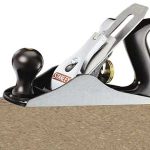When installing a fence, one of the most important jobs is ensuring that you have secure fence posts, that can hold the fence in place.
The posts should be strong enough to hold the fence plumb under its own weight. As well as providing extra support, for things like gale force wind.
In order to provide this strength, you will need to dig fence post holes, that are deep enough to provide support.
For the average fence, post holes should be at least two foot deep (600mm). This is a assuming your fence is roughly six feet tall.
In order to dig a post hole this deep, requires a specialist tool for the job. A standard shovel will not be able to dig this deep, without creating a hole that is too wide. The hole should only be a few inches wider than the post. This will enable you to add concrete around the post to secure it in place.

To do the job correctly, you need a tool that can dig deep narrow holes. There are several different tools that can help you do this. The most common can be seen below:
- Grafter shovel
- Post hole digger
- Manual fence post auger
- Automatic fence post auger
Any of these will do a decent job. However, which of these is the best tool for digging fence post holes? The truth is it really depends. Below we will look at the benefits and disadvantages of each. As well as how they can be combined, and an additional tool that can make the job easier.
Using a grafter to dig fence post holes
You could argue this is the most primitive option. However, it will do a good job and is relatively cheap. Also, this type of spade is usually very well made. Therefore, you will only need to buy one and this should last you for years (maybe forever). The chance of this tool breaking is extremely slim, and it requires practically no maintenance.
It is also a more general tool and can be used for other jobs around the garden, where digging is required.
Due to the shape and weight, it is also good at dealing with stones and roots, which can usually be dislodged or cut right through with the grafter.
When it comes to disadvantages, there aren’t many, but the main ones are:
- It can be hard work – This usually means you need to take breaks, especially if you’re digging lots of holes. Also, if your hands aren’t used to this type of digging, you can end up with some blisters. Some good gloves will help with this.
- You will have to manually remove dirt from the hole – Due to its design, the grafter is good at cutting through the earth. However, it isn’t great at removing all of it. For this you will need to get your arm down the hole and manually remove the dirt.
Overall this is a good tool, and it will dig perfectly good post holes. Also, if you are looking for a more versatile tool that can be used for other jobs, this is definitely a good one for the garden shed.
You can see our favourite grafter and read some customer reviews by clicking here
Using a post hole digger for your fence post holes
As the name suggests, this tool is specifically designed for this job. It has two articulated spade blades that are attached to two handles with a hinge between the spades. The handles allow you to open and close the blades in a pincer type action.
Due to this design, the blades can cut through the soil, and pressure can be applied to the handles to lift the earth out of the hole. This means you don’t have to manually get your arm down the hole, in order to remove excess dirt.
Just like the grafter, this is a manual tool, so some effort is required to drive it into the ground.
The main issue you may find, is due to its light weight and design, it doesn’t fair very well with rocks and roots. Unlike the grafter, you will often get stuck if you hit something harder.
Essentially, the grafter and the hole digger both have separate problems that the other solves. For this reason, they can actually work very well together.
To see a popular post hole digger click here
Digging fence post holes with a manual auger
The next tool is a manual fence post augur. This is probably the best manual tool for digging fence post holes in soft ground.
Out of all the manual tools, it is definitely the easiest from a labour perspective. Due to the spiral shape of the auger, it easily twists into the ground when you rotate the handles. Then when you pull it out of the ground, the loose earth comes with it. This means, you don’t have to bend down and manually remove much earth from the hole.
However, despite the ease of use in soft ground, harder rocky ground, and even roots are a different story. Unfortunately, this tool isn’t that effective in harder ground.
For this reason, having another tool such as a grafter handy, is a good idea.
You can see a good quality manual auger by clicking here
Automatic fence post auger
This is basically a motorised version of the manual auger. They are available in electric and petrol and are great if you have lots of holes to dig. They can definitely save a lot of time and energy.
However, just like the manual auger, they are not the biggest fan of rocky earth. You will often find the tool jams as soon as it hits something hard. This can really jolt the person holding the tool, and actually adds a manual element to drilling out the holes.
In particularly rocky or hard ground, this can actually be really hard work.
Basically, in soft ground this tool is a dream come true. However, it can be more difficult in tougher surfaces.
With that said, if you are digging a lot of holes, this tool will make the job quicker in most cases. Ideally, you would have a manual tool handy for any tougher ground, or rocks that need removing, but in general this will drill out very good post holes.
I have used a few different automatic augers over the years. My personal favourite, is this petrol model that you can see by clicking here
The best tool to help digging post holes
The biggest issue you face when digging with any of these tools, is hitting harder objects, such as rocks and roots.
Of the four we compared; the grafter is probably the best at dealing with these obstacles. However, even this tool will get stuck with particularly hard areas.
In order to avoid this, you need a tool that is designed for breaking and dislodging these types of obstructions. The best tool for this job is a wrecking bar.
Wrecking bars are made from hardened steel and are usually 5-6 foot long. They generally have a point or a chisel shaped end, designed for breaking stone, bricks, concrete, etc.
They are a heavy tool and deliver a huge amount to force into a small area. This means they are extremely effective at breaking through harder objects.
You can see a good wrecking bar by clicking here
Conclusion
So as you can see, there are good arguments for all these hole digging tools. Each brings a slightly different method to the table, and they are all capable of achieving a decent hole for your fence post.
However, which is the best tool for digging fence post holes?
This is a very tough question to answer, and the truth is, it will depend on the type of ground you are working with, as well as personal preference.
For me personally, I’m a little old school, and I like to use a grafter and also have a wrecking bar handy. However, in the right conditions, I have to say, a petrol fence post auger is a fantastic tool.
In my ideal scenario, I would use these three tools in combination. The auger can do the bulk of the work and the grafter and wrecking bar can be used to deal with tougher situations.




